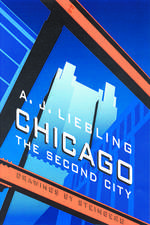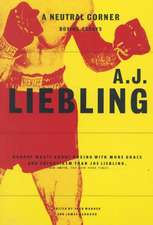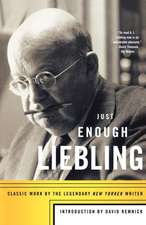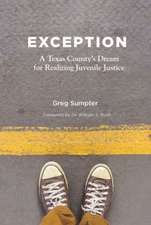The Telephone Booth Indian: Library of Larceny
Autor A.J. Lieblingen Limba Engleză Paperback – 30 iun 2004
Often referred to as “Liebling lowlife pieces,” the essays in The Telephone Booth Indian boisterously celebrate raffishness. A. J. Liebling appreciated a good scam and knew how to cultivate the scammers. Telephone Booth Indians (entrepreneurs so impecunious that they conduct business from telephone booths in the lobbies of New York City office buildings) and a host of other petty nomads of Broadway—with names like Marty the Clutch and Count de Pennies—are the protagonists in this incomparable Liebling work. In The Telephone Booth Indian, Liebling proves just why he was the go-to man on New York lowlife and con culture; this is the master at the top of his form, uncovering scam after scam and writing about them with the wit and charisma that established him as one of the greatest journalists of his generation and one of New York’s finest cultural chroniclers.
Preț: 106.64 lei
Nou
Puncte Express: 160
Preț estimativ în valută:
20.41€ • 21.23$ • 16.85£
20.41€ • 21.23$ • 16.85£
Carte disponibilă
Livrare economică 25 martie-08 aprilie
Preluare comenzi: 021 569.72.76
Specificații
ISBN-13: 9780767917360
ISBN-10: 0767917367
Pagini: 272
Dimensiuni: 131 x 203 x 16 mm
Greutate: 0.23 kg
Editura: BROADWAY BOOKS
Seria Library of Larceny
ISBN-10: 0767917367
Pagini: 272
Dimensiuni: 131 x 203 x 16 mm
Greutate: 0.23 kg
Editura: BROADWAY BOOKS
Seria Library of Larceny
Recenzii
“Liebling remains the nonpareil.” —Anthony Lewis
Notă biografică
A. J. LIEBLING joined the staff of The New Yorker in 1935 and stayed there until his death in 1963. His many books include The Earl of Louisiana, Back Where I Came From, Between Meals, and The Sweet Science, which was recently voted the finest sports book of all time.
Extras
* Masters of the Midway *
One of the most distinctive periodicals published in the land of the Telephone Booth Indians is called the Greater Show World, a trade paper for outdoor showmen. It is edited in one room in the Gaiety Building, which is not a fictional edifice, by a man named Johnny J. Kline who has five typewriters in his office and usually has a sheet of copy paper in each of them. When he sits at one typewriter he is editor-in-chief, at another he is business manager, and at a third a gossip columnist. He writes under different by-lines as two other reporters at the remaining typewriters. The magazine which he gets out all by himself every month is just as big as the New Yorker, he reminds me whenever I see him, and he says he wonders what the hell the New Yorker staff does for a living. Since the advertising and editorial departments of the Greater Show World are lodged in adjacent wrinkles of the same brain lobe, they sometimes get telescoped, and the result is a spontaneous eulogy for an advertiser. Through the years a pair of showmen named Lew Dufour and Joe Rogers have drawn more eulogies and paid for more ads than almost anybody else. The pair never got a chance to work near Telephone Booth Indian territory until Grover Whalen opened his World of Tomorrow over in Flushing Meadows in 1939. When that happened they showed they knew how to get a dollar.
Among the shows on the World's Fair midway presented by the firm of Dufour & Rogers, one, "We Humans," illustrated the grand strategy of evolution in a somewhat macabre fashion. A reverent, three-dimensional presentation of Da Vinci's "Last Supper," with life-sized models of the apostles, trick lighting effects, and a musical background of Gregorian chants supplied by a phonograph with an electrical record-changing device, was to have been another Dufour & Rogers offering. They could not find a suitable Catholic organization to sponsor the "Last Supper," so they dropped it. Rogers says, without any intended disrespect, "The nuns would not play ball with us." Dufour, the senior partner, saw no conflict in the subject matter of the "Last Supper" and "We Humans." He is a man of a speculative and scientific temperament. "We tell the customers about evolution," he says, "but we don't advocate it." Jang, a Malay boy with a tail six inches long, was a principal in "Strange as It Seems," another Dufour & Rogers attraction. Dufour wanted to invite all the inhabitants of Dayton, Tennessee, to come to see Jang and draw their own conclusions. Rogers, however, was against the necessary outlay for postage stamps.
As the partners had already rented a midway site for the abandoned religious spectacle, they substituted a hastily erected saloon and restaurant called the Rondevoo. The Rondevoo made its chief appeal to other concessionaires and their employees--an example of Dufour & Rogers resourcefulness, because, as Rogers said, "The attendance is off, but the boys have got to be here anyhow." The Rondevoo turned out to be their most profitable stab.
In deference to Dufour's scholastic leanings, Rogers, an earthy type, sometimes calls his partner "Dr. Itch." The firm believes in diversification of investments, as Dufour puts it, or, as Rogers says, spreading its bets. When the Fair opened, the partners had five shows and one ride, the Silver Streak, ready in the amusement area. They also had one of their evolution shows in operation at the San Francisco Fair. The New York shows were "We Humans"; "Strange as It Seems," which they described as a "de luxe Congress of Strange People, Presented in an Air-Cooled Odditorium"; the Seminole Village, the title of which is self-explanatory; "Nature's Mistakes," an exhibit featuring Adonis, the Bull with the Human Skin, and "Gang Busters," an epic depiction of the dangers and fascination of crime, with reformed gangsters reenacting the St. Valentine's Day Massacre and Juanita Hansen, a reformed movie actress, lecturing on the evils of narcotics, to which she said she was once addicted. They also added "Olga, the Headless Girl, Alive," and the restaurant. This list includes about every kind of proved midway attraction except a girl show, and that omission is due not to prudery but commercial principles. A girl show for a world's fair must have a rather elaborate installation, usually a name star, and always a considerable salary list. Moreover, one nude non-freak woman is much like another, and while it is certain that one or two of the dozen girl shows at a world's fair will make money, nobody can tell in advance which ones they will be. Freaks, crime, five-legged cows, and aborigines are staple midway commodities. At Flushing the five-legged cows came through for the firm, but the human freaks lost money.
Dufour and Rogers began their joint career at the Century of Progress Exposition in Chicago in 1933 and have figured conspicuously on the midways at San Diego, Dallas, Fort Worth, Cleveland, Brussels, and San Francisco since then. Long before 1933 they had worked separately in that curious world of sixty thousand outdoor show people, the "carnies," who travel from town to town with carnivals. A stranger once asked Joe Rogers whether he had started as a barker with a carnival. "Hell, no," Rogers replied. "I worked my way up to that." And anyway, he might have explained, no carnie says "barker." The man who holds forth outside the show to bring the people in is the "outside talker"; his oration is known as "the opening." The fellow who guides them about inside the exhibit is an "inside talker."
Banks, as might be expected, are reluctant to lend money to carnival people, so Dufour & Rogers finance their ventures largely by selling "pieces" of them to other men in the amusement business--owners of touring carnivals, manufacturers of slot machines, and retired circus proprietors. The ease with which they promote money from this skeptical investing public is evidence of their prestige in the profession. Outdoor showmen always refer to important sums as "paper money." When concessionaires with less of it ran through their bank rolls at past fairs, Dufour & Rogers bought them out. That way the firm wound up the second summer of the Greater Texas Exposition at Dallas with thirty-eight attractions on the midway, including the "Streets of Paris." The "Streets of Paris" was a girl show, but even a girl show may prove a good investment after the original proprietor's investment has been written off the books. The competition of pale-faced indoor showmen, like some of the concessionaires at the Fair who had a Broadway background, always makes Lew and Joe feel good. "Give me the sky for a canopy," Rogers once said, "and I will take Flo Ziegfeld and make a sucker out of him. How do you like that?" The difference between what will draw in Beloit, Wisconsin, and what will draw in New York, they think, is not basic, but is chiefly a matter of flash--the old vaudeville word for "class" or "style"--in presentation. "You can buy a ham sandwich at the Automat," Dufour says, "or you can buy it at the Waldorf. What's the difference? The Waldorf has more flash."
The partners have little of that pure enthusiasm for a freak as a freak that distinguishes some of their friends. A man named Slim Kelly, for example, who managed "Nature's Mistakes" for Dufour & Rogers, once spent three months and all his capital in the lumber country around Bogalusa, Louisiana, where he had heard there was a Negro with only one eye, and that in the center of his forehead. Kelly still believes the cyclops is somewhere near Bogalusa but that he may be self-conscious. Lew and Joe feel that the chance of finding a really new kind of freak is a tenuous thing on which to maintain a business.
Joe Rogers is a hyperactive man in his early forties, with contrapuntal eyes set in a round, sleek head. He has a boundless capacity for indignation, which he can turn on like a tap. Rogers' complexion, when he is in low gear, indicates rosy health. When he is angry, it carries a horrid hint of apoplexy. During the last few weeks before a fair opens, he carries on a war of alarums and sorties with contractors, delegates of labor unions, and officials of the concession department. His theory is sustained attack.
Once, on being approached by a stranger at the Fair grounds, Joe asked the man his business. "I'm a landscape architect," the stranger said. "Oh," Rogers yelled before beginning to bargain, "so you're the muzzler who's going to rob me!" He had a particularly bitter time with the contractor on one of his buildings in Flushing, a tall, solemn, chamber-of-commerce sort of fellow whose work Rogers regarded as slow and expensive. "He is a legit guy, a businessman," Rogers moaned one day, "and he tries to sell me a soft con!" "Con," of course, is a contraction of "confidence game." A soft con is one that begins with a plaint, as, "When I made this contract I didn't know the site was so marshy." A short con and a quick con are less humiliating variants because they are aimed at catching a victim off guard rather than insulting his intelligence. "Me, a showman, a snake guy!" Rogers continued. A snake guy is one who has exhibited snakes in a pit at a fair. The incongruity of the contractor's attempt to invert the natural order appeared to affect Rogers deeply. "Trying to cheat the cheaters!" he screamed. "I'll wrap a cane around his neck!" And he went out looking for the contractor.
Before he had gone three steps from his office in the "Strange as It Seems" building, however, he had become involved in a quarrel with two gypsies who sought employment in the Seminole Village. "Me Indian," said the first gypsy, who was swarthy enough to qualify. "You gypsy!" Rogers yelled. "You want to open a mitt joint in my concession! Get outa here!" A mitt joint is a booth for palm reading. Its bad feature, from the point of view of a respectable concessionaire, is the frequent disappearance of patrons' pocketbooks. This provokes beefs, which are bad for business. Rogers' life as opening day approaches is an assault in constantly accelerating tempo. Once a fair has opened, he goes to bed for twenty-four hours and wakes up thinking about the next fair on the international schedule.
Rogers was born in the Brownsville region of Brooklyn, but for the last fifteen years he has made his headquarters in the Hotel Sherman, a business and theatrical hotel in the Chicago Loop. He finds people out there more compatible. Dufour, however, lives in an apartment in Forest Hills. Between fairs the partners keep in touch by air line and long-distance telephone.
Lew Dufour is tall, sallow, and bland, and wears his dark clothes with a sort of mortuary elegance. Superficially, he does not resemble Rogers. "Mr. Dufour," a subordinate once said, "is a mental genius. Mr. Rogers is an executive genius." When Rogers fails to overwhelm an opponent in a business argument, Dufour takes up the task and wheedles him. It is a procedure used by teams of detectives to make criminals confess. As a unit, Lew and Joe are nearly irresistible. On propositions requiring dignity and aplomb, Dufour makes the first approach. At Chicago in 1934, however, Lew failed to impress General Charles G. Dawes, who was chairman of the finance committee for the Century of Progress. The partners had had a successful first season at the Fair, but the management wished to shift their "Life" show--an earlier edition of "We Humans"--to a less favorable site for the reprise of the Fair. When Dufour failed to move Dawes, Rogers leaned forward, pincered the general with his intercepting eyes, and shouted, "You can't do this to us, General! We are good concessionaires. We made a lot of money for the Fair." The general said, "How much did you make for yourselves?" "Oh," said Rogers, suddenly vague, "we made lots and lots." Rogers says he could hear the famous pipe rattling against the general's teeth from the force of the general's curiosity. "And what do you call lots of money, Mr. Rogers?" Joe's voice became a happy croon. "What I call lots of money, General, is lots and lots and lots." General Dawes permitted them to keep their old site. Presumably he hoped Rogers might relent someday and tell him. "I just worked on his curiosity," Joe says, "like I wanted him to come in and see a two-headed baby." The partners had made $111,000 on the "Life" show.
A favored type of investment among world's-fair concessionaires is an aboriginal village. Eskimos, Filipinos, or Ashantis usually can be hired at extremely moderate rates to sit around in an appropriate setting and act as if they were at home. The city dweller's curiosity about exotic peoples, built up by a childhood of reading adventure books, is apparently insatiable. Providing suitable food is not such a problem as it might seem once the concessionaire has learned the fact, unreported by anthropologists, that all primitive peoples exist by preference on a diet of hamburger steak. Dufour derives from this pervading passion a theory that all races of man once inhabited a common Atlantis, but Rogers does not go so far. He just says he is glad they do not crave porterhouse. Once engaged, the aborigine must be encouraged and, if necessary, taught to perform some harmless maneuver which may be ballyhooed as a sacred tribal rite, just about to begin, folks. This is ordinarily not difficult, as the average savage seems to be a good deal of a ham at heart.
Dufour & Rogers' debut as practical ethnologists was really caused by a large captive balloon that blew away from its moorings at the Century of Progress. The balloon had been one of the sights of the midway, and its taking off left a large site vacant. So Lew and Joe, who already had a couple of other shows, leased the space for a tropical village, which they called Darkest Africa. Some of the partners' acquaintances say they opened with a cast of tribesmen from South State Street, which is in the Chicago Black Belt, but Lew insists that he came to New York to engage them all. "Naturally, there was no time to go to Africa for performers on such short notice," he says, "but you would be surprised the number of real Africans there are in Harlem. They come there on ships."
By the time Dufour got back to Chicago with his company of hamburger-eating cannibals, Rogers had built the village, a kind of stockade containing thatched huts and a bar. "We had a lot of genuine junk, spears and things like that, that an explorer had brought from the bacteria of Africa," Joe Rogers says, "but this chump had gone back to Africa, so we did not know exactly which things belonged to which tribes--Dahomeys and Ashantis and Zulus and things like that. Somehow our natives didn't seem to know, either." This failed to stump the partners. They divided the stuff among the representatives of the various tribal groups they had assembled and invited the anthropology departments of the Universities of Chicago and Illinois to see their show. Every time an anthropologist dropped in, the firm would get a beef. The scientist would complain that a Senegalese was carrying a Zulu shield, and Lew or Joe would thank him and pretend to be abashed. Then they would change the shield. "By August," Joe says with simple pride, "everything in the joint was in perfect order."
One of the most distinctive periodicals published in the land of the Telephone Booth Indians is called the Greater Show World, a trade paper for outdoor showmen. It is edited in one room in the Gaiety Building, which is not a fictional edifice, by a man named Johnny J. Kline who has five typewriters in his office and usually has a sheet of copy paper in each of them. When he sits at one typewriter he is editor-in-chief, at another he is business manager, and at a third a gossip columnist. He writes under different by-lines as two other reporters at the remaining typewriters. The magazine which he gets out all by himself every month is just as big as the New Yorker, he reminds me whenever I see him, and he says he wonders what the hell the New Yorker staff does for a living. Since the advertising and editorial departments of the Greater Show World are lodged in adjacent wrinkles of the same brain lobe, they sometimes get telescoped, and the result is a spontaneous eulogy for an advertiser. Through the years a pair of showmen named Lew Dufour and Joe Rogers have drawn more eulogies and paid for more ads than almost anybody else. The pair never got a chance to work near Telephone Booth Indian territory until Grover Whalen opened his World of Tomorrow over in Flushing Meadows in 1939. When that happened they showed they knew how to get a dollar.
Among the shows on the World's Fair midway presented by the firm of Dufour & Rogers, one, "We Humans," illustrated the grand strategy of evolution in a somewhat macabre fashion. A reverent, three-dimensional presentation of Da Vinci's "Last Supper," with life-sized models of the apostles, trick lighting effects, and a musical background of Gregorian chants supplied by a phonograph with an electrical record-changing device, was to have been another Dufour & Rogers offering. They could not find a suitable Catholic organization to sponsor the "Last Supper," so they dropped it. Rogers says, without any intended disrespect, "The nuns would not play ball with us." Dufour, the senior partner, saw no conflict in the subject matter of the "Last Supper" and "We Humans." He is a man of a speculative and scientific temperament. "We tell the customers about evolution," he says, "but we don't advocate it." Jang, a Malay boy with a tail six inches long, was a principal in "Strange as It Seems," another Dufour & Rogers attraction. Dufour wanted to invite all the inhabitants of Dayton, Tennessee, to come to see Jang and draw their own conclusions. Rogers, however, was against the necessary outlay for postage stamps.
As the partners had already rented a midway site for the abandoned religious spectacle, they substituted a hastily erected saloon and restaurant called the Rondevoo. The Rondevoo made its chief appeal to other concessionaires and their employees--an example of Dufour & Rogers resourcefulness, because, as Rogers said, "The attendance is off, but the boys have got to be here anyhow." The Rondevoo turned out to be their most profitable stab.
In deference to Dufour's scholastic leanings, Rogers, an earthy type, sometimes calls his partner "Dr. Itch." The firm believes in diversification of investments, as Dufour puts it, or, as Rogers says, spreading its bets. When the Fair opened, the partners had five shows and one ride, the Silver Streak, ready in the amusement area. They also had one of their evolution shows in operation at the San Francisco Fair. The New York shows were "We Humans"; "Strange as It Seems," which they described as a "de luxe Congress of Strange People, Presented in an Air-Cooled Odditorium"; the Seminole Village, the title of which is self-explanatory; "Nature's Mistakes," an exhibit featuring Adonis, the Bull with the Human Skin, and "Gang Busters," an epic depiction of the dangers and fascination of crime, with reformed gangsters reenacting the St. Valentine's Day Massacre and Juanita Hansen, a reformed movie actress, lecturing on the evils of narcotics, to which she said she was once addicted. They also added "Olga, the Headless Girl, Alive," and the restaurant. This list includes about every kind of proved midway attraction except a girl show, and that omission is due not to prudery but commercial principles. A girl show for a world's fair must have a rather elaborate installation, usually a name star, and always a considerable salary list. Moreover, one nude non-freak woman is much like another, and while it is certain that one or two of the dozen girl shows at a world's fair will make money, nobody can tell in advance which ones they will be. Freaks, crime, five-legged cows, and aborigines are staple midway commodities. At Flushing the five-legged cows came through for the firm, but the human freaks lost money.
Dufour and Rogers began their joint career at the Century of Progress Exposition in Chicago in 1933 and have figured conspicuously on the midways at San Diego, Dallas, Fort Worth, Cleveland, Brussels, and San Francisco since then. Long before 1933 they had worked separately in that curious world of sixty thousand outdoor show people, the "carnies," who travel from town to town with carnivals. A stranger once asked Joe Rogers whether he had started as a barker with a carnival. "Hell, no," Rogers replied. "I worked my way up to that." And anyway, he might have explained, no carnie says "barker." The man who holds forth outside the show to bring the people in is the "outside talker"; his oration is known as "the opening." The fellow who guides them about inside the exhibit is an "inside talker."
Banks, as might be expected, are reluctant to lend money to carnival people, so Dufour & Rogers finance their ventures largely by selling "pieces" of them to other men in the amusement business--owners of touring carnivals, manufacturers of slot machines, and retired circus proprietors. The ease with which they promote money from this skeptical investing public is evidence of their prestige in the profession. Outdoor showmen always refer to important sums as "paper money." When concessionaires with less of it ran through their bank rolls at past fairs, Dufour & Rogers bought them out. That way the firm wound up the second summer of the Greater Texas Exposition at Dallas with thirty-eight attractions on the midway, including the "Streets of Paris." The "Streets of Paris" was a girl show, but even a girl show may prove a good investment after the original proprietor's investment has been written off the books. The competition of pale-faced indoor showmen, like some of the concessionaires at the Fair who had a Broadway background, always makes Lew and Joe feel good. "Give me the sky for a canopy," Rogers once said, "and I will take Flo Ziegfeld and make a sucker out of him. How do you like that?" The difference between what will draw in Beloit, Wisconsin, and what will draw in New York, they think, is not basic, but is chiefly a matter of flash--the old vaudeville word for "class" or "style"--in presentation. "You can buy a ham sandwich at the Automat," Dufour says, "or you can buy it at the Waldorf. What's the difference? The Waldorf has more flash."
The partners have little of that pure enthusiasm for a freak as a freak that distinguishes some of their friends. A man named Slim Kelly, for example, who managed "Nature's Mistakes" for Dufour & Rogers, once spent three months and all his capital in the lumber country around Bogalusa, Louisiana, where he had heard there was a Negro with only one eye, and that in the center of his forehead. Kelly still believes the cyclops is somewhere near Bogalusa but that he may be self-conscious. Lew and Joe feel that the chance of finding a really new kind of freak is a tenuous thing on which to maintain a business.
Joe Rogers is a hyperactive man in his early forties, with contrapuntal eyes set in a round, sleek head. He has a boundless capacity for indignation, which he can turn on like a tap. Rogers' complexion, when he is in low gear, indicates rosy health. When he is angry, it carries a horrid hint of apoplexy. During the last few weeks before a fair opens, he carries on a war of alarums and sorties with contractors, delegates of labor unions, and officials of the concession department. His theory is sustained attack.
Once, on being approached by a stranger at the Fair grounds, Joe asked the man his business. "I'm a landscape architect," the stranger said. "Oh," Rogers yelled before beginning to bargain, "so you're the muzzler who's going to rob me!" He had a particularly bitter time with the contractor on one of his buildings in Flushing, a tall, solemn, chamber-of-commerce sort of fellow whose work Rogers regarded as slow and expensive. "He is a legit guy, a businessman," Rogers moaned one day, "and he tries to sell me a soft con!" "Con," of course, is a contraction of "confidence game." A soft con is one that begins with a plaint, as, "When I made this contract I didn't know the site was so marshy." A short con and a quick con are less humiliating variants because they are aimed at catching a victim off guard rather than insulting his intelligence. "Me, a showman, a snake guy!" Rogers continued. A snake guy is one who has exhibited snakes in a pit at a fair. The incongruity of the contractor's attempt to invert the natural order appeared to affect Rogers deeply. "Trying to cheat the cheaters!" he screamed. "I'll wrap a cane around his neck!" And he went out looking for the contractor.
Before he had gone three steps from his office in the "Strange as It Seems" building, however, he had become involved in a quarrel with two gypsies who sought employment in the Seminole Village. "Me Indian," said the first gypsy, who was swarthy enough to qualify. "You gypsy!" Rogers yelled. "You want to open a mitt joint in my concession! Get outa here!" A mitt joint is a booth for palm reading. Its bad feature, from the point of view of a respectable concessionaire, is the frequent disappearance of patrons' pocketbooks. This provokes beefs, which are bad for business. Rogers' life as opening day approaches is an assault in constantly accelerating tempo. Once a fair has opened, he goes to bed for twenty-four hours and wakes up thinking about the next fair on the international schedule.
Rogers was born in the Brownsville region of Brooklyn, but for the last fifteen years he has made his headquarters in the Hotel Sherman, a business and theatrical hotel in the Chicago Loop. He finds people out there more compatible. Dufour, however, lives in an apartment in Forest Hills. Between fairs the partners keep in touch by air line and long-distance telephone.
Lew Dufour is tall, sallow, and bland, and wears his dark clothes with a sort of mortuary elegance. Superficially, he does not resemble Rogers. "Mr. Dufour," a subordinate once said, "is a mental genius. Mr. Rogers is an executive genius." When Rogers fails to overwhelm an opponent in a business argument, Dufour takes up the task and wheedles him. It is a procedure used by teams of detectives to make criminals confess. As a unit, Lew and Joe are nearly irresistible. On propositions requiring dignity and aplomb, Dufour makes the first approach. At Chicago in 1934, however, Lew failed to impress General Charles G. Dawes, who was chairman of the finance committee for the Century of Progress. The partners had had a successful first season at the Fair, but the management wished to shift their "Life" show--an earlier edition of "We Humans"--to a less favorable site for the reprise of the Fair. When Dufour failed to move Dawes, Rogers leaned forward, pincered the general with his intercepting eyes, and shouted, "You can't do this to us, General! We are good concessionaires. We made a lot of money for the Fair." The general said, "How much did you make for yourselves?" "Oh," said Rogers, suddenly vague, "we made lots and lots." Rogers says he could hear the famous pipe rattling against the general's teeth from the force of the general's curiosity. "And what do you call lots of money, Mr. Rogers?" Joe's voice became a happy croon. "What I call lots of money, General, is lots and lots and lots." General Dawes permitted them to keep their old site. Presumably he hoped Rogers might relent someday and tell him. "I just worked on his curiosity," Joe says, "like I wanted him to come in and see a two-headed baby." The partners had made $111,000 on the "Life" show.
A favored type of investment among world's-fair concessionaires is an aboriginal village. Eskimos, Filipinos, or Ashantis usually can be hired at extremely moderate rates to sit around in an appropriate setting and act as if they were at home. The city dweller's curiosity about exotic peoples, built up by a childhood of reading adventure books, is apparently insatiable. Providing suitable food is not such a problem as it might seem once the concessionaire has learned the fact, unreported by anthropologists, that all primitive peoples exist by preference on a diet of hamburger steak. Dufour derives from this pervading passion a theory that all races of man once inhabited a common Atlantis, but Rogers does not go so far. He just says he is glad they do not crave porterhouse. Once engaged, the aborigine must be encouraged and, if necessary, taught to perform some harmless maneuver which may be ballyhooed as a sacred tribal rite, just about to begin, folks. This is ordinarily not difficult, as the average savage seems to be a good deal of a ham at heart.
Dufour & Rogers' debut as practical ethnologists was really caused by a large captive balloon that blew away from its moorings at the Century of Progress. The balloon had been one of the sights of the midway, and its taking off left a large site vacant. So Lew and Joe, who already had a couple of other shows, leased the space for a tropical village, which they called Darkest Africa. Some of the partners' acquaintances say they opened with a cast of tribesmen from South State Street, which is in the Chicago Black Belt, but Lew insists that he came to New York to engage them all. "Naturally, there was no time to go to Africa for performers on such short notice," he says, "but you would be surprised the number of real Africans there are in Harlem. They come there on ships."
By the time Dufour got back to Chicago with his company of hamburger-eating cannibals, Rogers had built the village, a kind of stockade containing thatched huts and a bar. "We had a lot of genuine junk, spears and things like that, that an explorer had brought from the bacteria of Africa," Joe Rogers says, "but this chump had gone back to Africa, so we did not know exactly which things belonged to which tribes--Dahomeys and Ashantis and Zulus and things like that. Somehow our natives didn't seem to know, either." This failed to stump the partners. They divided the stuff among the representatives of the various tribal groups they had assembled and invited the anthropology departments of the Universities of Chicago and Illinois to see their show. Every time an anthropologist dropped in, the firm would get a beef. The scientist would complain that a Senegalese was carrying a Zulu shield, and Lew or Joe would thank him and pretend to be abashed. Then they would change the shield. "By August," Joe says with simple pride, "everything in the joint was in perfect order."
Descriere
In "The Telephone Booth Indian," Liebling proves just why he was the go-to man on New York lowlife and con culture; this is the master at the top of his form, uncovering scam after scam and writing about them with the wit and charisma that established him as one of New York's finest cultural chroniclers.



















